Creating a Rough Turning Operation | ||||
|
| |||
Create a Longitudinal Rough Turning Operation
You can create a Longitudinal Rough Turning operation in the Manufacturing Program.
Activate the Manufacturing Program and click Rough Turning
 in the Lathe Machining Operations toolbar.
in the Lathe Machining Operations toolbar.A Rough Turning entity is added to the Manufacturing Program.
The Rough Turning dialog box appears directly at the Geometry tab
 .
.
Note: Geometry tab includes a sensitive area to help you specify the geometry to be machined. The part and stock are colored red indicating that this geometry is required. All other geometry is optional.
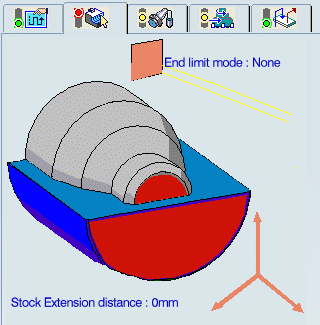
Still in the Geometry tab.
- Click the red part area in the Geometry tab and then select the
desired part profile in the 3D window.
See Selecting Edges and Faces to Define Geometry
The Automatic Link Type option
 allows you to select a first element and then
the element to navigate to in order to complete the profile selection.
The Axial/Radial and Radial/Axial Linking options are also useful for
profile selection.
allows you to select a first element and then
the element to navigate to in order to complete the profile selection.
The Axial/Radial and Radial/Axial Linking options are also useful for
profile selection. 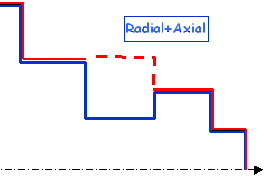
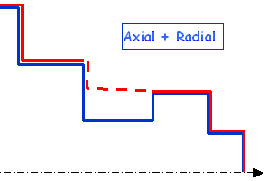
Once selected, the part areas changes color to green indicating that this geometry is now defined.
- Click the red stock area in the Geometry tab and then select the desired
stock profile in the 3D window.
Once selected, the stock areas changes color to green indicating that this geometry is now defined.
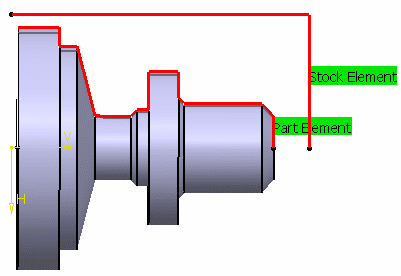
- Right-click the geometry to be assigned the local value,
and select the Add Local Information contextual command.
A dialog box appears allowing you to assign the desired local values. In addition to the global offsets that you can assign to the part profile, you can also add local offset values.
Other contextual commands are available for managing local information. Please refer to the Managing Local Information for more details.
- Set Part Offset to 5mm.
- Click the red part area in the Geometry tab and then select the
desired part profile in the 3D window.
Select the Strategy tab
 .
.- Specify the machining strategy parameters.
- Roughing mode: Longitudinal
- Orientation: External
- Location: Front
- Double-click Max depth of cut
Set this value to 2.5mm in the Edit Parameter dialog box and click OK.
- Set other parameters in the Option and User Parameters tab.
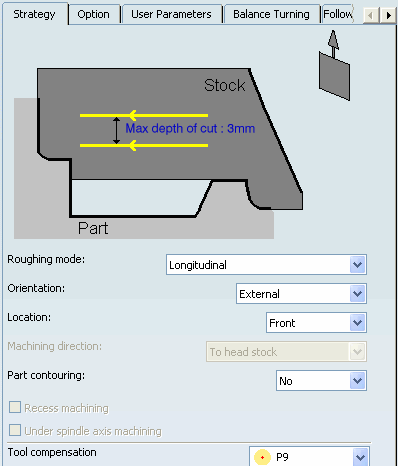
- Specify the machining strategy parameters.
Go to the Tool tab
 to select a tool.
to select a tool.Select the Feeds and Speeds tab
 to specify the feedrates and spindle speeds for the Machining Operation.
to specify the feedrates and spindle speeds for the Machining Operation. Select the Macros tab
 to specify the Machining Operation transition paths.
to specify the Machining Operation transition paths.For more information, please refer to the Define Macros on a Lathe Operation.
Click Tool Path Replay
 to check the validity of the Machining Operation.
to check the validity of the Machining Operation.The toolpath is computed.
- The tool path is computed.
- A progress indicator is displayed.
- You can cancel the tool path computation at any moment before 100% completion.
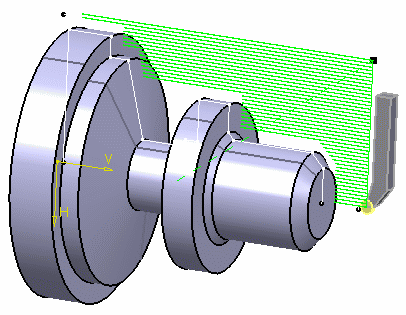
Click OK to create the Machining Operation.
![]()
Create a Face Rough Turning Operation
You can insert a Face Rough Turning operation in the Manufacturing Program.
Activate the Manufacturing Program and click Rough Turning
 in the Lathe Machining Operations toolbar.
in the Lathe Machining Operations toolbar.A Rough Turning entity is added to the Manufacturing Program.
The Rough Turning dialog box appears directly at the Geometry tab
 .
.
Note: Geometry tab includes a sensitive area to help you specify the geometry to be machined. The part and stock are colored red indicating that this geometry is required. All other geometry is optional.

Still in the Geometry tab.
- Click the red area in the Geometry tab and then select the
desired part profile in the 3D window.
The Selecting Edges and Faces to Define Geometry appears to help you with contour selection.
Once selected, the part areas changes color to green indicating that this geometry is now defined.
- Click the red stock in the area and then select the desired
stock profile in the 3D window.
Once selected, the stock areas changes color to green indicating that this geometry is now defined.
- Set Part Offset to 5mm.
- Click the red area in the Geometry tab and then select the
desired part profile in the 3D window.
Select the Strategy tab
 .
.- Specify the machining strategy parameters.
- Orientation: Face
- Location: External
- Location: Front
- Double-click the Max depth of cut.
Set this value to 2.5mm in the Edit Parameter dialog box and click OK.
- Set lift-off distance to 1.5mm In the Option tab.
- Set other parameters in the Option and User Parameters tab.
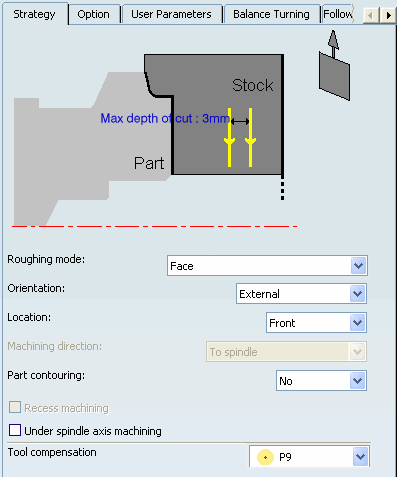
- Specify the machining strategy parameters.
Go to the Tool tab
 to select a tool.
to select a tool.Select the Feeds and Speeds tab
 to specify the feedrates and spindle speeds for the Machining Operation.
to specify the feedrates and spindle speeds for the Machining Operation.Select the Macros tab
 to specify the desired transition paths.
to specify the desired transition paths.Approach linking and retract linking motions are interruptible for this type of Machining Operation.
Click Tool Path Replay
 to check the validity of the Machining Operation.
to check the validity of the Machining Operation.- The tool path is computed.
- A progress indicator is displayed.
- You can cancel the tool path computation at any moment before 100% completion.

Click OK to create the Machining Operation.
![]()
Create a Parallel Contour Rough Turning Operation
You can insert a Parallel Contour Rough Turning operation in the Manufacturing Program.
Activate the Manufacturing Program and click Rough Turning
 in the Lathe Machining Operations toolbar.
in the Lathe Machining Operations toolbar.A Rough Turning entity is added to the Manufacturing Program.
The Rough Turning dialog box appears directly at the Geometry tab
 .
.
Note: Geometry tab includes a sensitive area to help you specify the geometry to be machined. The part and stock are colored red indicating that this geometry is required. All other geometry is optional.

Still in the Geometry tab.
- Click the red area in the Geometry tab and then select the
desired part profile in the 3D window.
The Selecting Edges and Faces to Define Geometry appears to help you with contour selection.
Once selected, the part areas changes color to green indicating that this geometry is now defined.
- Click the red stock in the area and then select the desired
stock profile in the 3D window.
Once selected, the stock areas changes color to green indicating that this geometry is now defined.
- Click the red area in the Geometry tab and then select the
desired part profile in the 3D window.
Select the Strategy tab
 .
.- Specify the machining strategy parameters.
- Double-click the Axial depth of cut.
Set this value to 3mm in the Edit Parameter dialog box and click OK.
- Double-click Radial depth of cut
Set this value to 3mm in the Edit Parameter dialog box and click OK.
- Set other parameters in the Option and User Parameters tab.

Note: When Recess machining check box is selected in the Parallel Contour Rough Turning, then Axial Depth of Cut and Radial Depth of Cut must have suitable values to ensure a collision free toolpath.
For more information, please refer to the Recommendations.
- Specify the machining strategy parameters.
Go to the Tool tab
 to select a tool.
to select a tool.Select the Feeds and Speeds tab
 to specify the feedrates and spindle speeds for the Machining Operation.
to specify the feedrates and spindle speeds for the Machining Operation. Select the Macros tab
 to specify the operation's transition paths.
to specify the operation's transition paths.For more information, please refer to the Define Macros on a Lathe Operation.
Click Tool Path Replay
 to check the validity of the Machining Operation.
to check the validity of the Machining Operation.- The tool path is computed.
- A progress indicator is displayed.
- You can cancel the tool path computation at any moment before 100% completion.
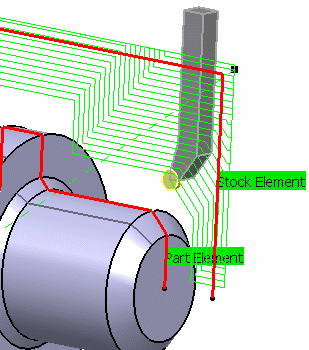
Click OK to create the Machining Operation.